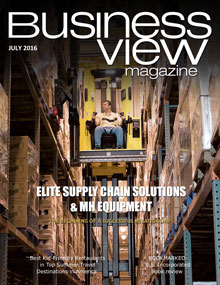Greenergy
The zero difference
Business View Magazine profiles Greenergy Communities , a builder of zero-energy, affordable homes. Headquarters in Seminole, Florida.
Paavo Salmi was not in the home building business. In fact, he calls himself “an online sales and marketing guy. Everything starts with marketing and sales; without sales there is no need for a product.” So how did someone who busied himself during the 1990s building the first online reservation engine on the web so that people could book their own Hawaiian vacations, wind up designing, building, and selling the latest in high-performance, zero-energy homes?
Well, like all entrepreneurs, he saw an opening in a marketplace that nobody else was filling, and thought that he could fill it himself. He joined forces with two other seasoned, business professionals -Jim Durda and Chuck Burkett – and formed Greenergy. “We had three partners, originally,” Salmi says, “and none of us had anything to do with home construction.” And yet when the City of Dunedin and the Pinellas, Florida Housing Authority put out an RFP for 25 town homes to be built in Dunedin, they bit. “That was about four or five years ago,” he continues. “We bid for that with some construction partners. Zero-energy had never been done before in that climate – 160 thousand, 180 thousand dollar town homes that are high-performance and zero-energy with solar, home automation, LED lighting – all the goodies.”
Salmi’s group did get a piece of the Dunedin contract, but the market wasn’t cooperating. The land was in a Florida land trust, and there were no mortgages being offered for homes planned for the area. In addition, the objective of the RFP was to keep the housing affordable; high-performance, zero-energy homes could always be built for the high end buyer, but never for the lower tiers. “So, the project kind of stalled and stalled, but it finally got re-started about mid-year, last year. And now, we have just about finished the first building and the first five units will be done in the next three weeks and then the rest of the buildings will be finished in two or three month intervals.”
So, what is a high-performance, zero-energy home, anyway? “You have a zero-energy home if your home produces as much or more energy as the home consumes in the course of a year. You will not have any energy costs,” Salmi says. And who gets to decide what zero-energy even means? “The Department of Energy set the guidelines for zero-energy homes; this is not something that we invented,” he replies. “Basically, every single home gets energy calculations as to what kind of energy consumption it’s expected to have. It’s like the MPG (miles per gallon) for cars. There is a third-party entity that comes in and they do the energy calculations. They say, for example, ‘this home is going to have a thousand kilowatt hours per month’ – that’s the consumption for the home.”
Once a home model is rated, Greenergy provides those energy calculations to its solar partner, Solar City, who designs the home’s rooftop solar photovoltaic array. “Our solar partner does the engineering based on the geo-locale of the home – they know exactly how much sunshine they get in that location, based on historical data – and then they size the system to produce as much energy as their calculations indicate. Now, here’s the caveat for that scenario: this is all based on the guidelines on how the home is to be used. So, if you leave your sliding doors open on a hot summer day for ten hours, you will have energy costs – there’s no question about it. However, if you use the home like it normally would be used, you will still get an electric bill, but it will just say ‘zero’ on it. Now, the other caveat of the net-zero energy concept is that in the summer months, you might have a twenty-dollar bill, but in the winter months, you will have a twenty-dollar credit. So, in the course of a year, you have a net-zero cost home. That’s how that works.” A third caveat is that in places where the electricity is created by solar energy but the water is heated by gas, the homes cannot be called net-zero energy homes, but rather net-zero electric homes.
The twenty-dollar credit to which Salmi alludes is based on the concept of “net-metering.” With net-metering, when a home’s solar system is making more electricity than is being consumed, such as on a long, sunny day, all of those excess electrons flow back into the power grid and the home’s electric meter goes backwards. Florida, like almost every other state in the country, has enacted net metering statutes that allow consumers to sell homemade electricity back to their power companies.
In order to have an efficient zero-energy home, however, the solar system has to be aligned with other energy-saving components. “The elements that we put in our homes include, of course, the solar, but we also have home automation as a standard element in every home we build,” says Salmi. “That’s for climate control and lighting control, which is directly relevant to the energy efficiency of the home. Then, we have LED lighting; we have well-insulated homes; we use impact glass windows; we have hybrid water heaters that have a much more efficient way of heating the water; and the air ducts are not in the attic – they are actually below the ceiling inside of the air conditioned space. So your AC is not running through a 150-degree attic. That feature alone saves about 25 percent of your energy costs. So, when you start combining these elements, they all have a significant impact on the energy consumption of the home.”
And Salmi says that all of those elements inside the home help make what is going on top of it, much less expensive. “Now, when we put that solar system on the roof, it is much smaller than typically you would need to satisfy the energy need of the home.”
Today, Greenergy is beginning to come into its own. Its construction company is branching out and home projects are either on the boards or underway in several Florida and California locations. In Florida, Greenergy builds most of its own structures. The California homes have been contracted to local construction company that is already established, knows all the jurisdiction’s building codes, the markets, the vendors, etc. “We design and engineer the home and go to them,” says Salmi. “’Here’s our specs, please provide us a cost for these homes,’ and then we sign a contract.”
“Right now, the very first village that is being finished under our company name and brand is the EcoVillage Madeira Beach. It sold out in 10 days pre-construction. It is seven homes, and we’re probably about 30 days away from all homes being done and completed.” In the Tampa area, a Newland Communities project in Apollo Beach called Waterset is a master-planned community with about 1,000 lots and homes built so far, with 5,000 at maturity. “We just launched EcoVillage Waterset and it looks like we’ll be building there another ten years.” says Salmi. “We just got approved as a builder and we took our first 80 lots. And we are now building our zero-energy home model between D.R. Horton and David Weekley. So, it’s really a game-changer. We are bringing this product to the marketplace and competing directly with the national builders.”
Several other Greenergy projects are in different phases of development. “Dunedin is the next one that will be completed – 25 town homes will be done later this year; Waterset is just starting – we are in the process of building the model home and the first couple of spec homes; EcoVillage-Bakersfield, California – we are finalizing the site development; EcoVillage River Place – we are in the process of building the first building; Mezzaluna Springs – all the entitlements are done and the next step is to start the site development. So they all are in different stages and all is based on utilizing the exact same product across the board, meaning a net-zero electric, or net-zero energy home, depending on the project in question.”
Now that construction is burgeoning, Salmi’s long experience in sales and marketing completes the Greenergy business model. “Not only do we have a product that nobody else is bringing to the marketplace, we also have a business model that really doesn’t exist, elsewhere,” he says. “We have, probably, the most sophisticated, cloud-based sales and marketing platform that exists in this industry. We have developed something that allows us to get in front of about 400-plus real estate portals out in cyberspace and reach a hundred million people looking for homes every day and every month. And based on that platform, we manage all of these projects from the marketing and sales perspective from here in our St. Petersburg offices.
“In Port St. Lucie we established Greenergy Realty as a full-service real estate company that handles all the sales on the ground. We have the same thing in California, same thing in Pinellas County. And all that is managed by the marketing and sales perspective from this location. So we have full visibility. We know every phone call, every email correspondence, every response between a sales person and a prospect anywhere in the country at any given time, in real time. Here in the Pinellas County area, we are generating over 400 buyer prospects, every month. We do not spend one cent in marketing. Yet we sold over a hundred homes, pre-construction, last year.”
Greenergy hosts a team of between ten and fifteen people, Salmi explains – most of whom are in sales. “Everything else, we outsource,” he says. “We don’t have people in-house. We utilize a third-party design company, Dave Jenkins, who’s probably the leading zero-energy designer in the country. We were fortunate to find the partners in the civil engineering, design, and especially the construction side who have done this for decades. They have the experience and professionalism and expertise to do this. So, we are way ahead of anybody else in the sales and marketing side, and on the construction side, we really have an extremely solid foundation with our team having built thousands of homes in Florida and elsewhere.”
Among all of Greenergy’s different projects, the company has over a thousand homes “coming off the ground. And this really is the first active year for us,” Salmi reports. “Last year was still R&D and developing our sales and marketing platform and getting ready to go. Now, going from zero to a thousand homes in such a short period of time is also giving us a lot of economies of scale compared to smaller, local and regional builders. They don’t have those elements to play with. And now that we have a couple of projects that have shown us that we can actually do what we preach, and with the experienced professionals on our team, we have all the elements in place to provide the proper execution of projects. So, our goal is to complete somewhere between 75 and 100 homes this year, and then steadily grow over the following years in different areas.”
The future for Greenergy looks very bright, indeed, especially since Salmi, the “sales and marketing guy” can be counted upon to forever be following the first rule of sales: A, B, C – Always Be Selling. “So we talk about the Greenergy difference,” he pitches. “We provide a home that has elements that are tough to find anywhere else. There really isn’t anybody else doing it the way we do it. We are unique. We bring these homes to the marketplace and there are no premium costs. So, when you compare our products to the resale market, or the new homes in an area, our homes are priced in line with anything else. This really can be done.”
And Greenergy is proving it every day.
Check out this handpicked feature on Mackenzie Milne – 170 years strong.
AT A GLANCE
WHO: Greenergy Communities
WHAT: A builder of zero-energy, affordable homes
WHERE: : Headquarters in Seminole, Florida
WEBSITE: www.planetgreenergy.com
PREFERRED VENDORS
DIG DIGITAL?


